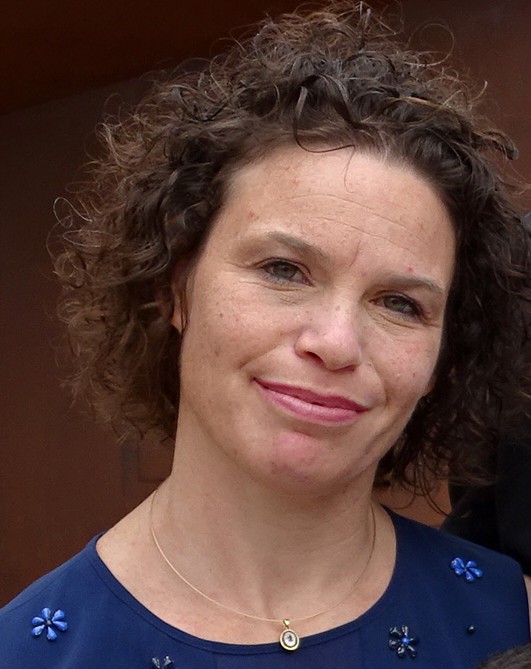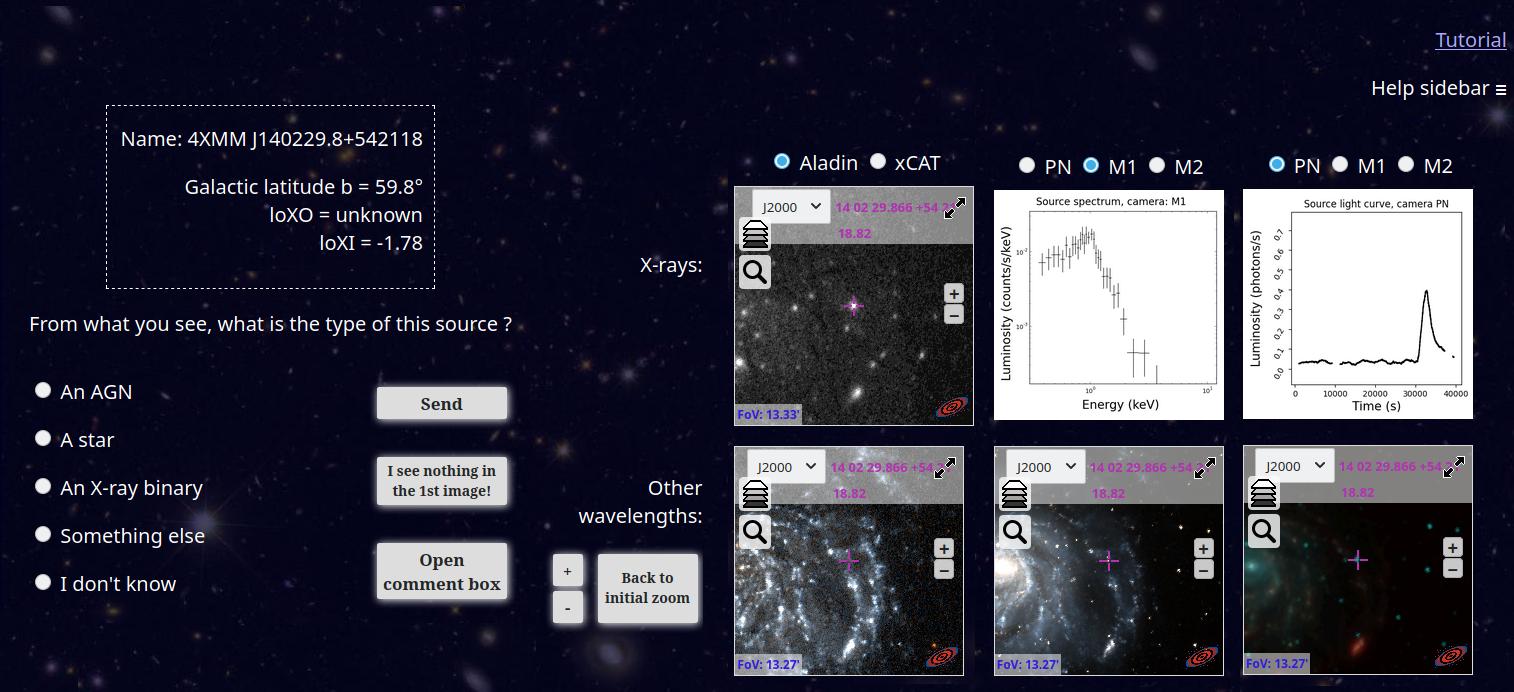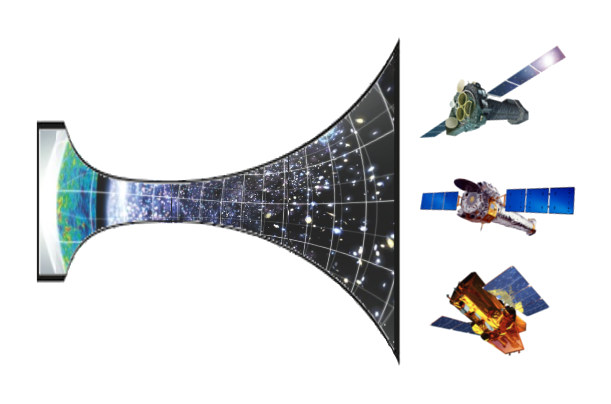To understand the elements of the high-energy Universe and answer key questions such as how supermassive black holes formed, we need your help to identify objects detected in X-rays. X-ray catalogues are getting bigger and bigger (they will soon reach 1 million detections), so the study of individual objects is becoming difficult for astrophysicists. At IRAP, the Research Institute for Astrophysics and Planetary science located in Toulouse, France, we would like to invite citizens to participate in this identification and to do this, we have developed this platform. After months of work, the beta version of the website was released on September, 24th, and about 2000 classifications were realized in just a week. We hope that you will enjoy identifying X-ray sources and we look forward to the advances in astrophysics that we will make thanks to your participation! 😃
The XMM-Newton mission
Two decades ago, on December 19th, 1999, the X-ray observatory XMM-Newton (XMM stands for X-ray multi-Mirror Mission) was launched into space on board an Ariane 5 rocket. Still active today, this observatory of the European Space Agency has cameras amongst the most sensitive and mirrors amongst the most powerful ever developed in the world, making it a major instrument in the history of X-ray astronomy.
In twenty years, XMM-Newton has therefore revolutionized our view of the high-energy Universe, teaching us much about neutron stars, the environment of supermassive black holes, exotic events such as when a star is destroyed and swallowed by a black hole, and many other celestial phenomena. But this success story would not have been possible without the scientists managing the operations of the satellite, and those developing the algorithms and the catalogues which make XMM-Newton data accessible. This is done by the European Space Agency's
Science Operation Center at the European Space Astronomy Centre near Madrid and the XMM-Newton
Survey Science Centre, a consortium of 10 European institutes directed by Dr. Natalie Webb at IRAP.
The CLAXSON team:
Dr. Hugo Tranin

Hugo completed his PhD at the Institut de Recherche en Astrophysique et Planétologie (IRAP), Toulouse, France in November 2022. During his PhD, he looked for treasures hidden in X-ray catalogues, such as
intermediate-mass black holes, thanks to machine learning algorithms and the modeling of "tidal disruption events". One of the conclusions of his work is that his algorithms require a larger training sample (previously identified sources), hence he developed CLAXSON with the help of Natalie Webb and Mickael Coriat.
Dr. Natalie Webb

Natalie is a multi-wavelength astronomer at IRAP, and head of the XMM-Newton Survey Science Centre, which develops much of the software to reduce XMM-Newton data, in collaboration with
ESA, and produces catalogues of XMM-Newton serendipitous detections and sources. Natalie’s research is focused on the origin and the growth of supermassive black holes, and on constraining the nature of the supra-dense matter inside neutron stars.
Dr. Mickael Coriat

Mickael is a multi-wavelength astronomer at IRAP. After a PhD on the relativistic jets produced by black holes, he became specialist of radio and X-ray observations. He also holds the
XMM-Newton source catalogue and the
XMM-Newton survey science centre websites, so he was of a precious help to put CLAXSON online.
Welcome to this new citizen science website! Here you will be able to classify X-ray celestial sources on your own and help shed light on the high-energy Universe by making new astrophysical discoveries!
X-ray astronomy deals with the study of X-ray observation and detection of astronomical objects. X-rays are a form of light beyond the energies our eye and our skin are used to detect and feel. They were first discovered and studied in 1895 by Wilhelm Röntgen in lab experiments, but until the 1960s, astronomers did not know of any stars or galaxies that shone in X-rays. Because Earth’s atmosphere absorbs most X-rays, X-ray telescopes and detectors are taken to high altitudes or into space by balloons and spacecraft, and the advent of such instruments led to groundbreaking discoveries of other very bright sources like Scorpius X-1, the first X-ray source detected outside our Solar System, found in the constellation Scorpius.
Since then, the X-ray Universe has revealed an incredible
richness in types of sources and effects they have on their environment: from the supermassive black holes found at the center of all massive galaxies (each one weighing more than a million Suns!) to exotic objects formed following the death of massive stars (neutron stars, magnetars, X-ray binaries, cataclysmic variables…) and even some of the most violent explosions known in the Universe so far (supernovae, gamma-ray bursts), the study of X-ray sources is an exciting field of astronomy which has revolutionized our knowledge and still faces a lot of open questions. What is the origin of supermassive black holes? What is the nature of the matter in a neutron star? What is causing the very high temperatures of stellar coronae, making them visible in X-rays? Where do short gamma-ray bursts come from?
To answer these questions, we often need large samples of observations, and here is the rub: we have no efficient way to identify all of the objects detected in X-ray - more than half a million objects. Analyzing them individually is a very long job for one person to do, and artificial intelligence requires a large learning sample to do a reliable job. In this context we tried an approach completely new for our field: citizen science. Citizen science is based on the wisdom of crowds: if you have to guess the weight of a cow by just seeing it, you will probably give a bad estimate. But if you average the estimates of a whole crowd, you will get a result very close to reality! Based on this principle, scientists have already developed many studies (notably gathered in the
Zooniverse website). We want to do the same for X-ray astronomy, and we have put together this platform to enable you to join the adventure. You are all able to help us, so please subscribe, explore the tutorial and have fun in contemplating and discovering new supermassive black holes, stars and other objects that have never been identified!
 Preview of the website. The object at the center of the images was first thought to be a very luminous so-called "X-ray binary", that is a couple made up of a neutron star or a black hole and a massive star, but was recently found to rather be a highly magnetic, low-mass star.
Preview of the website. The object at the center of the images was first thought to be a very luminous so-called "X-ray binary", that is a couple made up of a neutron star or a black hole and a massive star, but was recently found to rather be a highly magnetic, low-mass star.
Who would have believed it? ;)






